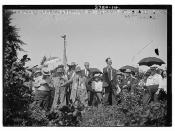The concept of freedom is one openly displayed in many of the famous artworks in history; it also seeps through into the less famous. This concept, though apparently straightforward, is a broad topic encompassing many views and aspects. IN the chosen artworks, "freedom" is developed as equality and trust, in an economic sense, a governmental sense and a basic human-rights sense. Not all artists take the dominant approach either - freedom is as personal as it is universal.
The artwork, "Lenin in Red Dawn" by Boris Vladimirski, is a powerful comment on Socialist Russia. Lenin, one of the main figureheads of the communist movement - some even call him the "Father of Communism" - is standing before a red dawn, as is stated by the work's title. Rather than use obvious methods of anti-political art, Vladimirski's oil on cardboard work utilises two major techniques to pass on his message.
The first technique used, the foremost of the two, is that of the red dawn behind Lenin.
As well as being the colour of the Communist Party in socialist Russia, red is also a colour that is deeply interconnected with human moods and symbolism.
Red is symbolic of passion, power and desire, also, too much red can be associated with anger; hence the saying: "seeing red". Thus, the backdrop of red over the foregrounded image of Lenin can take on many meanings. A passionate man, addressing the proletariat of the time, it may be taken to mean Lenin was a man of fervour for his cause. While the aforementioned is true, the dominant view taken in this work, however, is that of red symbolising power.
The second, and less obvious, technique is that of gesture. Lenin himself stands in a powerful pose, the wind sweeping his clothes back. Standing in opposition...


